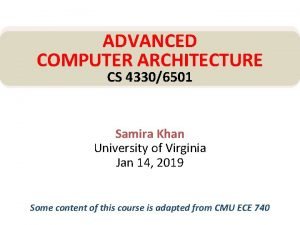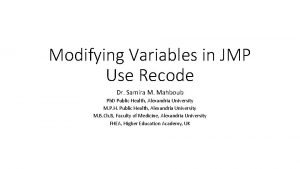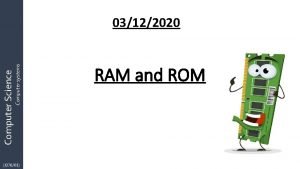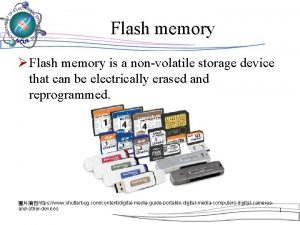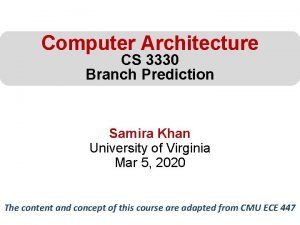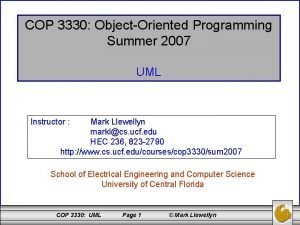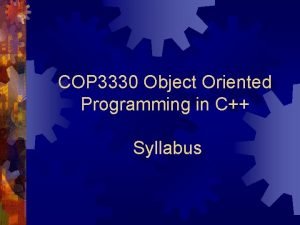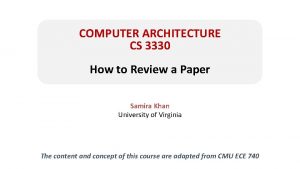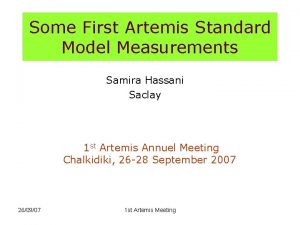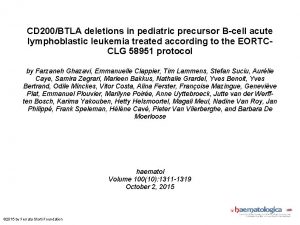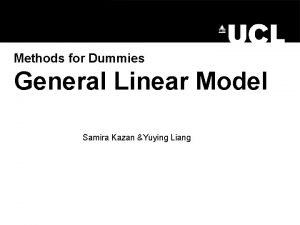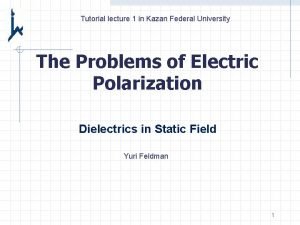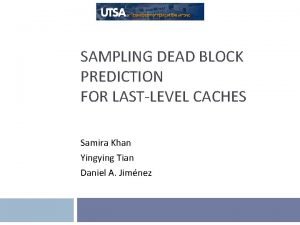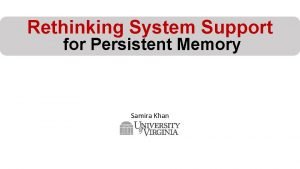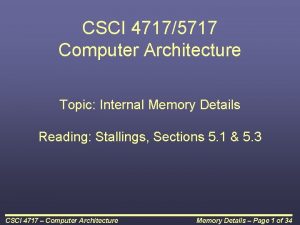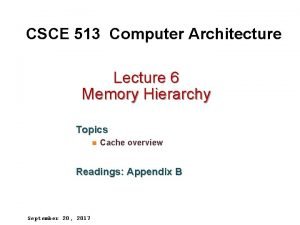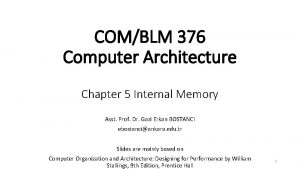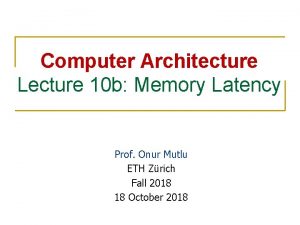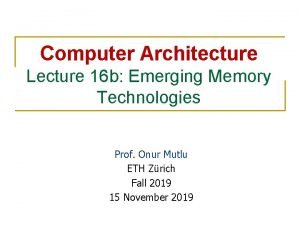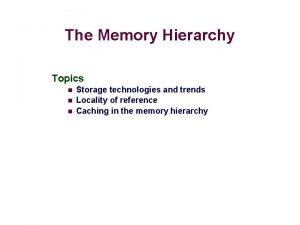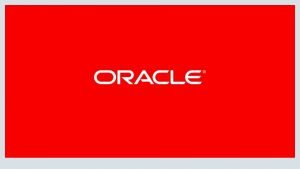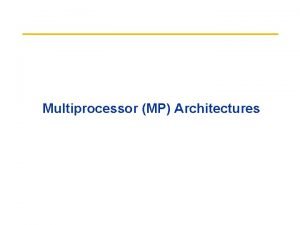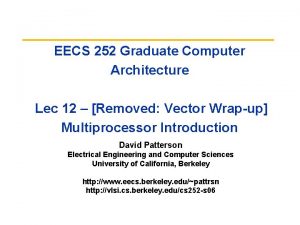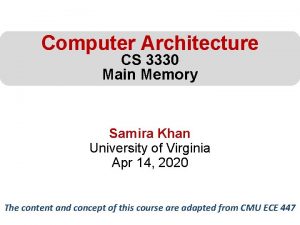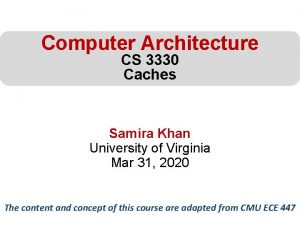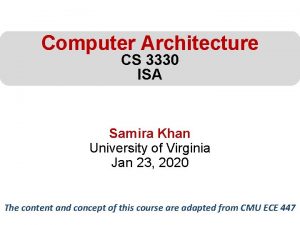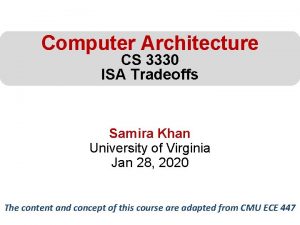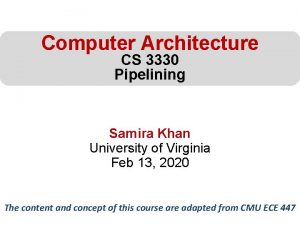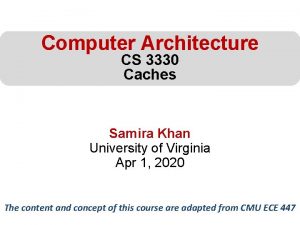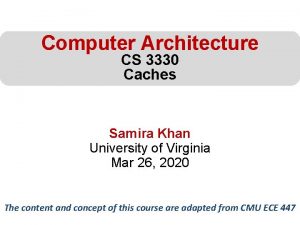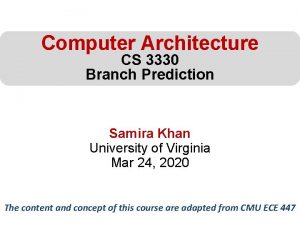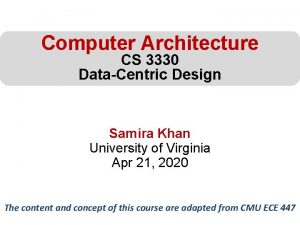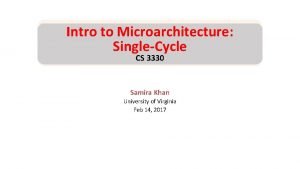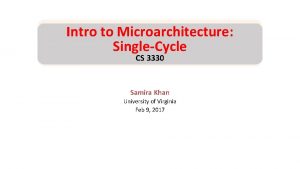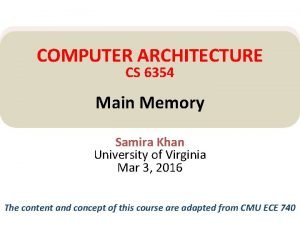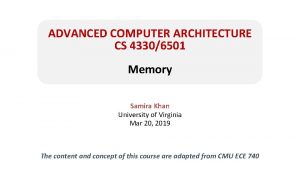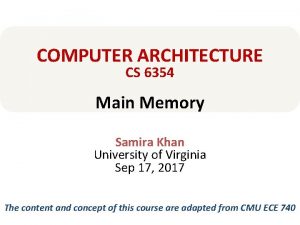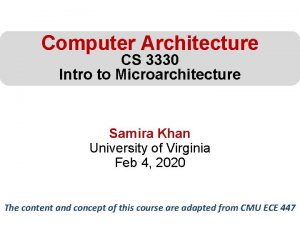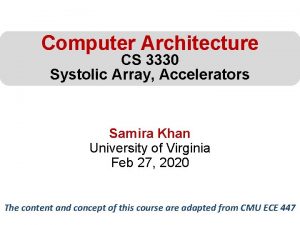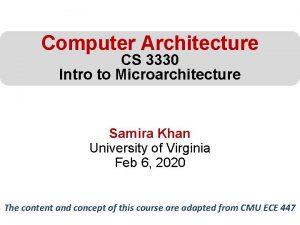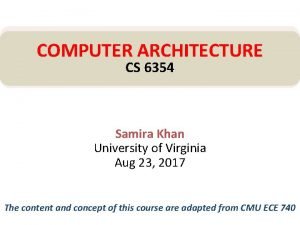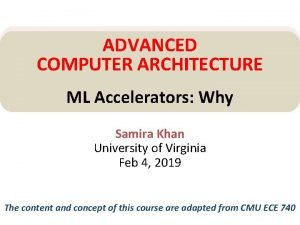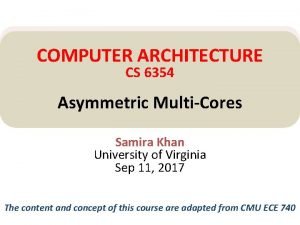Computer Architecture CS 3330 NonVolatile Memory Samira Khan












































- Slides: 44

Computer Architecture CS 3330 Non-Volatile Memory Samira Khan University of Virginia Apr 16, 2020 The content and concept of this course are adapted from CMU ECE 447

AGENDA • Logistics • Review from last lecture • Non-Volatile Memory 2

LOGISTICS • HW 5: Extra Credit – Out Apr 15, 2020 – Due Apr 22, 2020 • Exam 2 – Apr 28, 2020 – Take-home exam – Lecture 12 -23 – Branch prediction is important! – Practice homework questions 3

DRAM Subsystem Organization • • Channel DIMM Rank Chip Bank Row/Column Cell 4

DRAM CONTROLLER: FUNCTIONS • Ensure correct operation of DRAM (refresh and timing) • Service DRAM requests while obeying timing constraints of DRAM chips – Constraints: resource conflicts (bank, bus, channel), minimum write-to-read delays – Translate requests to DRAM command sequences • Buffer and schedule requests to improve performance – Reordering, row-buffer, bank, rank, bus management • Manage power consumption and thermals in DRAM – Turn on/off DRAM chips, manage power modes 5

DRAM SCHEDULING POLICIES (I) • FCFS (first come first served) – Oldest request first • FR-FCFS (first ready, first come first served) 1. Row-hit first 2. Oldest first Goal: Maximize row buffer hit rate maximize DRAM throughput – Actually, scheduling is done at the command level • Column commands (read/write) prioritized over row commands (activate/precharge) • Within each group, older commands prioritized over younger ones 6

The Main Memory System Processor and caches Main Memory Storage (SSD/HDD) • Main memory is a critical component of all computing systems: server, mobile, embedded, desktop, sensor • Main memory system must scale (in size, technology, efficiency, cost, and management algorithms) to maintain performance growth and technology scaling benefits 7

Major Trends Affecting Main Memory (I) • Need for main memory capacity, bandwidth, Qo. S increasing • Main memory energy/power is a key system design concern • DRAM technology scaling is ending 8

SOLUTIONS TO THE DRAM SCALING PROBLEM • Two potential solutions – Tolerate DRAM (by taking a fresh look at it) – Enable emerging memory technologies to eliminate/minimize DRAM • Do both – Hybrid memory systems 9

SOLUTION 2: EMERGING MEMORY TECHNOLOGIES • Some emerging resistive memory technologies seem more scalable than DRAM (and they are non-volatile) • Example: Phase Change Memory – Expected to scale to 9 nm (2022 [ITRS]) – Expected to be denser than DRAM: can store multiple bits/cell • But, emerging technologies have shortcomings as well – Can they be enabled to replace/augment/surpass DRAM? 10

HYBRID MEMORY SYSTEMS CPU DRAM Fast, durable Small, leaky, volatile, high-cost DRA MCtrl PCM Ctrl Phase Change Memory (or Tech. X) Large, non-volatile, low-cost Slow, wears out, high active energy Hardware/software manage data allocation and movement to achieve the best of multiple technologies

THE PROMISE OF EMERGING TECHNOLOGIES • Likely need to replace/augment DRAM with a technology that is – Technology scalable – And at least similarly efficient, high performance, and fault-tolerant • or can be architected to be so • Some emerging resistive memory technologies appear promising – Phase Change Memory (PCM)? – Spin Torque Transfer Magnetic Memory (STT-MRAM)? – Memristors? – And, maybe there are other ones – Can they be enabled to replace/augment/surpass DRAM? 12

CHARGE VS. RESISTIVE MEMORIES • Charge Memory (e. g. , DRAM, Flash) – Write data by capturing charge Q – Read data by detecting voltage V • Resistive Memory (e. g. , PCM, STT-MRAM, memristors) – Write data by pulsing current d. Q/dt – Read data by detecting resistance R 13

LIMITS OF CHARGE MEMORY • Difficult charge placement and control – Flash: floating gate charge – DRAM: capacitor charge, transistor leakage • Reliable sensing becomes difficult as charge storage unit size reduces 14

EMERGING RESISTIVE MEMORY TECHNOLOGIES • PCM – Inject current to change material phase – Resistance determined by phase • STT-MRAM – Inject current to change magnet polarity – Resistance determined by polarity • Memristors/RRAM/Re. RAM – Inject current to change atomic structure – Resistance determined by atom distance 15

WHAT IS PHASE CHANGE MEMORY? • Phase change material (chalcogenide glass) exists in two states: – Amorphous: Low optical reflexivity and high electrical resistivity – Crystalline: High optical reflexivity and low electrical resistivity PCM is resistive memory: High resistance (0), Low resistance (1) PCM cell can be switched between states reliably and quickly 16

HOW DOES PCM WORK? • Write: change phase via current injection – SET: sustained current to heat cell above Tcryst – RESET: cell heated above Tmelt and quenched • Read: detect phase via material resistance – Amorphous vs. crystalline Large Current Small Current Memory Element SET (cryst) Low resistance Access Device 103 -104 W RESET (amorph) High resistance 106 -107 W Photo Courtesy: Bipin Rajendran, IBM Slide Courtesy: Moinuddin Qureshi, IBM 17

OPPORTUNITY: PCM ADVANTAGES • Scales better than DRAM, Flash – Requires current pulses, which scale linearly with feature size – Expected to scale to 9 nm (2022 [ITRS]) – Prototyped at 20 nm (Raoux+, IBM JRD 2008) • Can be denser than DRAM – Can store multiple bits per cell due to large resistance range – Prototypes with 2 bits/cell in ISSCC’ 08, 4 bits/cell by 2012 • Non-volatile – Retain data for >10 years at 85 C • No refresh needed, low idle power 18

PHASE CHANGE MEMORY PROPERTIES • Surveyed prototypes from 2003 -2008 (ITRS, IEDM, VLSI, ISSCC) • Derived PCM parameters for F=90 nm • Lee, Ipek, Mutlu, Burger, “Architecting Phase Change Memory as a Scalable DRAM Alternative, ” ISCA 2009. 19

PHASE CHANGE MEMORY PROPERTIES: LATENCY • Latency comparable to, but slower than DRAM • Read Latency – 50 ns: 4 x DRAM, 10 -3 x NAND Flash • Write Latency – 150 ns: 12 x DRAM • Write Bandwidth – 5 -10 MB/s: 0. 1 x DRAM, 1 x NAND Flash 20

PHASE CHANGE MEMORY PROPERTIES • Dynamic Energy – 40 u. A Rd, 150 u. A Wr – 2 -43 x DRAM, 1 x NAND Flash • Endurance – – Writes induce phase change at 650 C Contacts degrade from thermal expansion/contraction 108 writes per cell 10 -8 x DRAM, 103 x NAND Flash • Cell Size – 9 -12 F 2 using BJT, single-level cells – 1. 5 x DRAM, 2 -3 x NAND (will scale with feature size) 21

PHASE CHANGE MEMORY: PROS AND CONS • Pros over DRAM – Better technology scaling – Non volatility – Low idle power (no refresh) • Cons – – Higher latencies: ~4 -15 x DRAM (especially write) Higher active energy: ~2 -50 x DRAM (especially write) Lower endurance (a cell dies after ~108 writes) Reliability issues (resistance drift) • Challenges in enabling PCM as DRAM replacement/helper: – Mitigate PCM shortcomings – Find the right way to place PCM in the system – Ensure secure and fault-tolerant PCM operation 22

PCM-BASED MAIN MEMORY: SOME QUESTIONS • Where to place PCM in the memory hierarchy? – Hybrid OS controlled PCM-DRAM – Hybrid OS controlled PCM and hardware-controlled DRAM – Pure PCM main memory • How to mitigate shortcomings of PCM? • How to take advantage of (byte-addressable and fast) non-volatile main memory? 23

PCM-BASED MAIN MEMORY (I) • How should PCM-based (main) memory be organized? • Hybrid PCM+DRAM [Qureshi+ ISCA’ 09, Dhiman+ DAC’ 09, Meza+ IEEE CAL’ 12]: – How to partition/migrate 24 data between PCM and DRAM

HYBRID MEMORY SYSTEMS: CHALLENGES • Partitioning – Should DRAM be a cache or main memory, or configurable? – What fraction? How many controllers? • Data allocation/movement (energy, performance, lifetime) – Who manages allocation/movement? – What are good control algorithms? – How do we prevent degradation of service due to wearout? • Design of cache hierarchy, memory controllers, OS – Mitigate PCM shortcomings, exploit PCM advantages • Design of PCM/DRAM chips and modules – Rethink the design of PCM/DRAM with new requirements 25

PCM-BASED MAIN MEMORY (II) • How should PCM-based (main) memory be organized? • Pure PCM main memory [Lee et al. , ISCA’ 09, Top Picks’ 10] : – How to redesign entire hierarchy (and cores) to overcome PCM shortcomings 26

AN INITIAL STUDY: REPLACE DRAM WITH PCM • Lee, Ipek, Mutlu, Burger, “Architecting Phase Change Memory as a Scalable DRAM Alternative, ” ISCA 2009. – Surveyed prototypes from 2003 -2008 (e. g. IEDM, VLSI, ISSCC) – Derived “average” PCM parameters for F=90 nm 27

Results: Naïve Replacement of DRAM with PCM • Replace DRAM with PCM in a 4 -core, 4 MB L 2 system • PCM organized the same as DRAM: row buffers, banks, peripherals • 1. 6 x delay, 2. 2 x energy, 500 -hour average lifetime • Lee, Ipek, Mutlu, Burger, “Architecting Phase Change Memory as a Scalable DRAM Alternative, ” ISCA 2009. 28

ARCHITECTING PCM TO MITIGATE SHORTCOMINGS • Idea 1: Use multiple narrow buffers in each PCM chip Reduces array reads/writes better endurance, latency, energy • Idea 2: Write into array at cache block or word granularity Reduces unnecessary wear 29 DRAM PCM

RESULTS: ARCHITECTED PCM AS MAIN MEMORY • 1. 2 x delay, 1. 0 x energy, 5. 6 -year average lifetime • Scaling improves energy, endurance, density • Caveat 1: Worst-case lifetime is much shorter (no guarantees) • Caveat 2: Intensive applications see large performance and energy hits • Caveat 3: Optimistic PCM parameters? 30

OTHER OPPORTUNITIES WITH EMERGING TECHNOLOGIES • Merging of memory and storage – e. g. , a single interface to manage all data • New applications – e. g. , ultra-fast checkpoint and restore • More robust system design – e. g. , reducing data loss • Processing tightly-coupled with memory – e. g. , enabling efficient search and filtering 31

STORAGE MEMORY CPU TWO-LEVEL STORAGE MODEL Ld/St DRAM FILE I/O VOLATILE FAST BYTE ADDR NONVOLATILE SLOW BLOCK ADDR 32

STORAGE MEMORY CPU TWO-LEVEL STORAGE MODEL Ld/St DRAM FILE I/O VOLATILE FAST NVM BYTE ADDR PCM, STT-RAM NONVOLATILE SLOW BLOCK ADDR Non-volatile memories combine characteristics of memory and storage 33

VISION: UNIFY MEMORY AND STORAGE CPU NVM PERSISTENT MEMORY Ld/St Provides an opportunity to manipulate persistent data directly 34

COORDINATED MEMORY AND STORAGE WITH NVM (I) • The traditional two-level storage model is a bottleneck with NVM – Volatile data in memory a load/store interface – Persistent data in storage a file system interface – Problem: Operating system (OS) and file system (FS) code to locate, translate, buffer data become performance and energy bottlenecks with fast NVM stores Two-Level Store Load/Store fopen, fread, fwrite, … Operating system and file system Virtual memory Address translation Main Memory Processor and caches Storage (SSD/HDD) 35

COORDINATED MEMORY AND STORAGE WITH NVM • Goal: Unify memory and storage management in a single unit to eliminate wasted work to locate, transfer, and translate data • Opportunity to update data in-place in memory with Ld/St interface • Do not need to move data from disk to memory, translate file to data structure and transfer to disk again – Eliminates wasted work to locate, transfer, and translate data – Improves both energy and performance – Simplifies programming model as well Meza+, “A Case for Efficient Hardware-Software Cooperative Management of Storage and Memory, ” WEED 2013. 36

THE PERSISTENT MEMORY MANAGER (PMM) Persistent objects PMM uses access and hint information to allocate, migrate and access data in the heterogeneous array of devices 37

ENERGY BENEFITS OF A SINGLE-LEVEL STORE ~24 X ~5 X Results for Post. Mark 38

ENERGY BENEFITS OF A SINGLE-LEVEL STORE ~16 X ~5 X Results for Post. Mark 39

CHALLENGE: NEED ALL STORAGE SYSTEM SUPPORTS APPLICATION OS/SYSTEM Ld/St MEMORY STORAGE FILE I/O Encryption Crash Consistency NVM Availability Security APPLICATION OS/SYSTEM Ld/St PERSISTENT MEMORY Overhead in OS/storage layer overshadows the benefit of nanosecond access latency of NVM 40

CRASH CONSISTENCY PROBLEM Add a node to a linked list 2. Link to prev 1. Link to next System crash can result in inconsistent memory state 41

ENABLING AND EXPLOITING NVM: ISSUES • Many issues and ideas from technology layer to algorithms layer • Enabling NVM and hybrid memory – How to tolerate errors? – How to enable secure operation? – How to tolerate performance and power shortcomings? – How to minimize cost? • Exploiting emerging technologies – How to exploit non-volatility? – How to minimize energy consumption? – How to exploit NVM on chip? 42

SUMMARY OF EMERGING MEMORY TECHNOLOGIES • Key trends affecting main memory – End of DRAM scaling (cost, capacity, efficiency) – Need for high capacity – Need for energy efficiency • Emerging NVM technologies can help – PCM or STT-MRAM more scalable than DRAM and non-volatile – But, they have shortcomings: latency, active energy, endurance • We need to enable promising NVM technologies by overcoming their shortcomings • Many exciting opportunities to reinvent main memory at all layers of computing stack 43

Computer Architecture CS 3330 Non-Volatile Memory Samira Khan University of Virginia Apr 16, 2020 The content and concept of this course are adapted from CMU ECE 447
 Samira khan uva
Samira khan uva Samira khan uva
Samira khan uva Dr samira khan
Dr samira khan Is rom volatile or nonvolatile
Is rom volatile or nonvolatile Flash memory structure
Flash memory structure Cs3330
Cs3330 Rotary district 3330
Rotary district 3330 Cop 3330 ucf
Cop 3330 ucf Fsu cop 3014
Fsu cop 3014 Cs 3330
Cs 3330 Artemis
Artemis Samira zegrari
Samira zegrari Samira kazan
Samira kazan Fatemeh soltani
Fatemeh soltani Samira kazan origin
Samira kazan origin Samira w block
Samira w block How to counter samira
How to counter samira Memory system design
Memory system design Explain virtual memory in computer architecture
Explain virtual memory in computer architecture Memory hierarchy in computer architecture
Memory hierarchy in computer architecture Internal memory in computer architecture
Internal memory in computer architecture Memory hierarchy
Memory hierarchy Memory organisation in computer architecture
Memory organisation in computer architecture Internal memory in computer architecture
Internal memory in computer architecture Memory latency in computer architecture
Memory latency in computer architecture Emerging memory technologies
Emerging memory technologies Memory heirarchy
Memory heirarchy 3 bus architecture
3 bus architecture Difference computer organization and architecture
Difference computer organization and architecture Basic computer organisation and design
Basic computer organisation and design Episodic vs semantic memory
Episodic vs semantic memory Difference between implicit and explicit memory
Difference between implicit and explicit memory Long term memory vs short term memory
Long term memory vs short term memory Internal memory and external memory
Internal memory and external memory Primary memory and secondary memory
Primary memory and secondary memory Logical memory is broken into
Logical memory is broken into Which memory is the actual working memory?
Which memory is the actual working memory? Page fault
Page fault Virtual memory in memory hierarchy consists of
Virtual memory in memory hierarchy consists of Eidetic memory vs iconic memory
Eidetic memory vs iconic memory Shared memory vs distributed memory
Shared memory vs distributed memory In-memory database architecture
In-memory database architecture Share a single centralized memory
Share a single centralized memory Symmetric shared memory architecture
Symmetric shared memory architecture Nand flash architecture
Nand flash architecture

